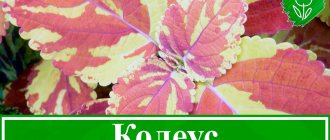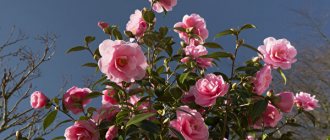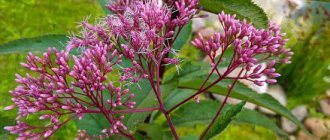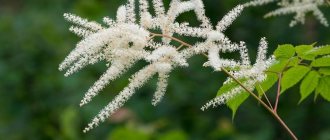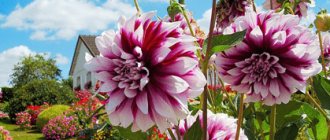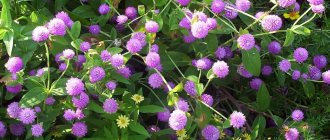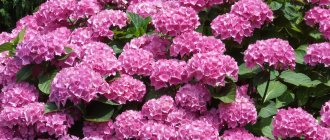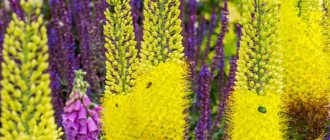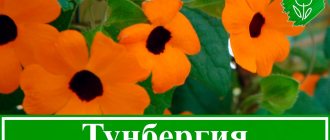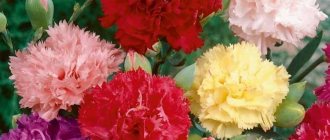- June 19, 2019
- garden plants
- Anastasia Efremenkova
In this article we will talk about the features of a plant such as bergenia, planting and caring for it in the garden. In general, bergenia is a herb and belongs to the Saxifraga family. The herb also has a second name - bergenia. This perennial herb can be found in its natural environment in China, Korea, and Central Asian countries. It prefers rocky soil, so it most often grows in rock cracks. Bergenia entered the culture in the 18th century. It received its second name from the botanist Carl August von Bergen. Now only 10 species of this grass are known, but breeders have managed to develop many more varieties. So, next we’ll find out what care and planting of bergenia in open ground include.
general description
Bergenia can be presented in the form of both perennial and annual plants that have a horizontal root system and can reach a height of 35 centimeters. The leathery leaves of bergenia are collected in basal rosettes; in almost all species, the leaves are dark green and located on long petioles. The flowers are goblet-shaped. The color palette is not too diverse. The most common flowers are white, pink or red. They are collected in paniculate inflorescences. Bergenia blooms begin around the end of May or early June, depending on the climate of the area. Please note that up to 120 flowers can be collected in one inflorescence. Bergenia also has a fruit - a seed capsule.
Quite often, bergenia is used in landscape design. This plant goes especially well with stones and crops such as phlox and hosta. Let's move on to the features of caring for and planting bergenia in open ground.
Use in landscape design
Colorful varieties of bergenia are suitable for forming multi-level flower beds of medium and large dimensions. Bergenia is planted more often at the foot or on the penultimate step. In the shade, the crop produces juicy and large foliage, in the sun it pleases with abundant flowering, the leaves are less lush.
The perennial shows itself best when decorating paths, the foreground of flower beds and flower beds, as an evergreen ground cover, an element of large mixborders. Saxifraga is also used as a tapeworm, placing the plant against the backdrop of a well-groomed emerald lawn. In autumn, the culture attracts attention to the changes in green and red tones.
With proper care, bergenia actively grows and delights with colorful flowering.
Types and varieties of bergenia
Below we will describe the types and varieties of bergenia that can most often be found in cultivation.
- Badan Strechi. It has oblong, ovoid leaves. Small teeth can be seen along the edges of these leaves. The length of the leaf is 8-10 centimeters, and the width is only 3-5 centimeters. Peduncles can reach 40 centimeters in height. They bear white or lilac-pink flowers, which are collected in racemose inflorescences. Among the best varieties of the species, Alba, Belvedere and Beethoven should be highlighted. Belvedere is different in that it grows in height to only 20 centimeters. And its white flowers gradually, during the flowering process, become pink.
- Bergenia thickleaf. Planting and caring for thick-leaved bergenia does not cause any problems. In addition, this type is most often used in medicine. It differs from other species in that it has two types of shoots: leafless flowering and vegetative rosette. On the vegetative shoots there are rather large leathery leaves that have an obovate shape. Their bright green color turns fiery red in autumn. The flowers are bell-shaped and collected in dense inflorescences. The best varieties are considered to be: Hydroruspe (a fairly tall plant - up to 60 centimeters, blooms for almost two months), Purpurea (the shrub can reach half a meter in height), Senor.
- Bergenia cordifolia. This is a variety of thick-leaved bergenia. It has rounded dark green leaves. Lilac, bell-shaped flowers are collected in racemes. Flowering begins in May. This plant came into cultivation in 1779.
- Hissar bergenia. One of the rarest species. It has rosette leaves, obovate in shape, covered with thick cilia along the edges. The flowers are located on peduncles 20 centimeters long. 6-8 white or pinkish flowers are collected in racemose inflorescences.
- Bergenia hybrid. This species includes varieties that are most often found in cultivation: Abenglut (its bright green leaves acquire a bronze-brown tint by autumn and has double flowers); Frau Holle (distinguished from other varieties by its snow-white flowers); Morgen Rothe (this variety blooms twice per season); Baby Doll (has beautiful flowers that are pale pink at the beginning of flowering and later become dark cream).
Species and varietal diversity
There are more than 10 types of bergenia found in nature, and a great variety of bred varieties. The most common:
1. Cordifolia:
- variety Rosie Close,
- overture variety,
- pinkdragonfly variety.
2. thick-leaved:
- Andrea variety,
- Beethoven variety,
- Morgenrot.
3. Pacific.
Breeders are constantly bringing out exotic new bergenia products, but they are reaching us extremely slowly. Varieties differ in early, late or repeat flowering.
Sowing seeds
It is recommended to sow bergenia before winter. Choose a suitable box and fill it with flower soil. Next, it is necessary to make grooves in the soil, the depth of which should not exceed five millimeters. The distance from one groove to another should be three centimeters. After they are ready, you should spill them with warm water, and then lay out the seeds and immediately sprinkle them with soil. After planting, the box must be taken outside and placed under the snow. At the beginning of March, it will need to be brought indoors and placed in partial shade. The air temperature in the room should not fall below +18-19 degrees.
Combination with other plants
Plants that bergenia does not combine with are lily of the valley, periwinkle, sedge. Low plants that reproduce by creeping rhizomes cannot coexist next to bergenia. They simply interfere with each other.
If the flowerbed is located in the shade or partial shade, then excellent neighbors:
- Mahonia;
- astilbe;
- host;
- ozhika;
- juniper;
- fern;
- sarcoccocus;
- lungwort;
- hellebore.
Bulbous plants go well with bergenia:
- crocus;
- snowdrop;
- narcissus;
- hyacinth;
- tulip;
- goose onion;
- woodland
After flowering, bulbous plants lose their special attractiveness. Bergenia, growing, covers all available space and the flowerbed does not lose its well-groomed appearance.
Pink bergenia flowers go well with small blue scylla and forget-me-not flowers. It looks cute and romantic. Scylla wakes up early after winter; in tandem with frost-resistant bergenia, they are the first to decorate the garden and notify everyone about spring. The green perennial is unpretentious, which allows it to be combined with many plants, including annuals.
Bergenia seedlings
Within three weeks after you bring the box of bergenia into the house, the first shoots will appear. Caring for bergenia seedlings is not difficult. It is necessary to periodically loosen the soil and carry out timely watering. But remember that you need to moisten the soil only when its top layer is dry. Also, do not forget to ventilate the room and remove weak shoots so that they do not interfere with the development of stronger ones. Sometimes it happens that a green crust appears on the surface of the earth. It indicates that the root system receives too much water, and because of this, oxygen ceases to flow to the roots.
Decoction
You will need a tablespoon of chopped roots. The contents are placed in an enamel bowl and boiling water is added. You will need a glass of boiling water. The decoction is prepared in a water bath.
The dishes with steamed roots are placed in a pan of water and kept on low heat for half an hour. The roots must be stirred periodically. The resulting liquid is cooled naturally. In order to make the most of the beneficial properties of the roots, they must be squeezed out.
The resulting amount of decoction will be less than a glass. Boiled water is added to the required volume (200 g).
Take 40 g, it is better to drink before meals. Three times a day will be enough to strengthen the immune system and suppress infections.
Bergenia pick
In May, the first picking of bergenia seedlings is carried out. They are transplanted into a new box. The distance from one seedling to another should be 5-7 centimeters in a row. But the distance between the rows is 15 centimeters. Decide in advance when you will plant bergenia in open ground. Because a few weeks before this, you should start hardening off the seedlings. The box with seedlings is taken out onto the loggia or balcony. It is better to start with one hour of stay there, gradually increasing the time. When the seedlings have been on the balcony for a day, you can safely start planting them in open ground.
Schmidt's bergenia (B. x schmidtii, or B. stracheyi var. Schmidtii)
Hybrid bergenia from cross-pollination of plants of different species were first obtained in the 19th century. An example of such a culture is Schmidt's bergenia, which has absorbed the features of thick-leaved and ciliated bergenia.
This plant is easy to distinguish from other varieties by its glossy leaves with jagged edges. Dense leaf plates are preserved under the snow. In the spring, when flower shoots appear above them, foliage growth stops and resumes with the withering of the inflorescences and the formation of seed pods.
White, purple or pink flowers up to 5 mm in diameter open from May to July or August. In the fall, seeds ripen and can be sown immediately to produce spring seedlings.
Disembarkation time
Caring for and planting bergenia plants should not cause you any difficulties. By following simple rules, you can easily achieve success. In general, experienced gardeners recommend planting bergenia at the end of August, since the seedlings develop rather slowly. But if you see that you have strong seedlings, you can plant them in June. As for everyone else, it is better to carry out another pick and let the seedlings grow and get stronger. Bergenia seedlings will be completely ready for transplanting into open ground in August.
Disembarkation rules
So, how do you plant bergenia in the garden and care for the planted seedlings?
The root system of bergenia is quite weak and is located horizontally. Therefore, for planting seedlings, you should choose loose and light alkaline soil. Quite often it happens that the roots of the bergenia begin to peek out from under the ground. You should think about this in advance, since in this position they may overheat in the sun. To prevent this from happening, you should choose a shaded area for planting bergenia. It is better if it is the northern, northeastern or northwestern part of your site. If you cannot plant bergenia in such a place, then immediately after planting, lay a layer of mulch in the root zone. This will allow the soil to dry out more slowly, and the root system will be protected from sunlight. Be sure to take into account the fact that moisture should never stagnate in the roots of bergenia. He can't stand it.
So, he proceeds directly to planting bergenia. It is necessary to make holes in the soil, the depth of which should be 6-8 centimeters. It is better to arrange them in the garden bed in a checkerboard pattern. The bottom of each hole should be covered with a layer of sand, which will act as drainage. The seedlings are transferred into the holes directly with a lump of earth and immediately dug in. Immediately after planting the seedlings, it is necessary to water the beds. The development and growth of bergenia is quite slow, so you will have to be patient. In the first two years there is no need to wait for flowering. Typically, bergenia blooms in the fourth year after planting in open ground.
Bergenia thick-leaved (B. crassifolia)
Bergenia bergenia has become widely known due to the medicinal properties of the roots and leaves, which are used to prepare an aromatic tart decoction. A traditional drink among the peoples of Altai and Mongolia, it perfectly tones and resists infections and inflammation. Thanks to him, bergenia received the name “Mongolian tea” and was included in the list of medicinal plants.
Wild bergenia, in the photo, can be seen in the foothills of Altai and the Sayan Mountains, in the north of Mongolia and in Transbaikalia. Curtains of this plant enliven the expanses of rocky wastelands in Kazakhstan and China.
Bergenia is a herbaceous perennial. The underground system of the plant consists of thick rhizomes located almost on the surface of the soil, giving rise to short, densely leafy shoots and peduncles with dense paniculate inflorescences.
As you can see in the photo of bergenia flowers, the bell-shaped corollas can be painted in all shades of white, pink, lilac and purple.
Leaf rosettes of large obovate leaves do not die off even in winter, so greenery appears literally from under the snow, with the first rays of the spring sun. The leathery, smooth leaf blades are bright green during the growing season, and closer to autumn they turn red and purple.
Rules of care
Usually, planting cordifolia bergenia and caring for it do not cause any problems for the gardener, but this also applies to other types and varieties of this plant. Since bergenia is an evergreen herb, after winter, when the snow melts, damaged leaves remain on it, which should be removed in the spring. You also need to remove shoots that have grown too much or have been damaged. After pruning, complex mineral fertilizer should be applied so that the bergenia can regain its strength and begin to grow. The next feeding will be needed two weeks after the end of bergenia flowering; during this period the plant also needs to regain its strength. Because after flowering, new leaves begin to appear on it. It is better to use Kemira combi as a fertilizer. The solution is easy to prepare. For ten liters of water you will need only one tablespoon of fertilizer. This amount is usually enough for two square meters of flower bed.
A mandatory point when learning the rules for caring for and planting bergenia in open ground is watering. As already mentioned, bergenia does not tolerate waterlogging of the soil, so it needs to be watered only at certain periods. The first time is when the buds begin to form, then when flowering begins, and the third time two weeks after flowering ends. However, even this schedule should be followed if the summer turns out to be dry. If there has been rain, then there is no need to water the bergenia. In the wild, bergenia itself is able to protect its roots. This is possible thanks to dying leaves that remain in the root zone. But in culture, it is customary to remove such leaves in order to maintain the decorativeness and beauty of the area where the plant is planted. When removing such leaves, you need to get rid of the cuttings. But the root system will be perfectly protected by a layer of mulch laid directly under the bushes.
As for planting bergenia seeds, caring for seedlings was described above. There are no difficulties in this option either. However, gardeners prefer to propagate the plant by dividing the bush.
Features of growing a perennial plant
Bergenia is not the most capricious plant, so not only an experienced gardener, but also a beginner can cope with it. It can be grown almost throughout the entire territory of our country, however, in hot, dry areas, care will be complicated by frequent watering. In this case, it is better to plant it in partial shade - under trees or on the north side of the building. In general, bergenia can withstand summer temperatures up to +30°C and above, the main thing is that in hot weather it receives enough moisture and is shaded during the midday hours.
Planting in open ground
For good growth and flowering, it is important to choose a suitable place in the garden. Here the opinions of experts differ - some believe that a sunny area is necessary for flowering, others advocate partial shade. And here only personal experience will become the best adviser.
When choosing a place for bergenia, as with any other plant, it is necessary to take into account the climate of the area. For example, a sunny area in Siberia or the Moscow region is a quite comfortable place for many types of plants, while at the same time, not every weed can withstand the sun in the Southern Urals. Therefore, when choosing a place for a plant, you need to make allowances for climatic conditions - in the steppe zone with scorching sun and dry winds, it is better if the area is shaded, ideally - near a pond; in a temperate climate, sun or partial shade is suitable.
Bergenia prefers light, loose soil. The fact is that the powerful rhizome of the plant lies close to the surface and this soil structure will provide it with the necessary moisture and nutrients. Sometimes the roots are too close and even come out, so the ground around it needs to be mulched, especially in sunny places. The composition of the soil is not particularly important, but waterlogging should be avoided. You cannot plant a flower in places with possible spring flooding.
Planting and growing bergenia in flower pots
Bergenia planted in tubs or flowerpots is a real decoration of the summer garden. The plant develops well and blooms in a container, and it can also be easily moved if the chosen location turns out to be unsuccessful.
To plant in a pot or tub you need:
- Pour drainage into the bottom of the pot - expanded clay, pebbles or crushed stone, ¼ of the volume.
- Fill half the container with the prepared mixture - turf soil, leaf soil, compost, sand in a ratio of 2:2:1:1.
- Place the prepared bergenia rosette in the center (if it is not planted in a composition) and cover it with the remaining soil.
- Lightly press the soil around the plant and water.
- Mulch the surface with bark, pebbles or decorative crushed stone.
When choosing a pot or tub for bergenia, you need to make sure there are good drainage holes. To prevent them from becoming clogged with soil during watering, shards are placed on the bottom, and a drainage layer is placed on top.
Planted in a flowerpot, bergenia feels no worse than in a flowerbed
For the winter, the flower pot or tub with a flower must be moved to a greenhouse or veranda and covered with lutrasil. Plants grown in southern regions where frost does not fall below 5°C can overwinter in containers outside. In all other regions there is a risk of the pot cracking from frost and the roots freezing.
Reproduction options
Propagation of bergenia can be carried out in two ways: by seeds or vegetatively, i.e. by dividing the bush. From year to year, the bergenia grows more and more, as a result of which new rosettes with a root system are formed. The roots of such rosettes are located quite close to the soil surface, so you can dig them up fairly quickly and not damage the mother rhizome. For division, you should choose middle-aged plants that have large leaves. It is necessary to separate the rosette along with the heel from the mother rhizome. The most suitable period is considered to be May-August.
Please note that each rhizome must have at least three living buds. All leaves of the dug cuttings must be removed; you can leave only two or three, but only the youngest ones. For divisions, holes should be prepared in advance. Their depth should be 3-5 centimeters, and the distance from each other should be 30-40 centimeters. With such a transplant, the bergenia takes root quite quickly, and already in the second year it will be possible to see its flowering. And the first year after planting, the plant grows a rosette.
Transplanting bergenia: when is the best time to do it?
Badan does not like frequent transplants, since it is a perennial, it can remain in one place for more than a dozen years. However, it is necessary to take into account the fact that it is growing quite strongly in breadth, capturing territories that did not belong to it. Therefore, it is recommended to replant the bergenia every five to six years. Experienced flower growers claim that the first half of September is best suited for this process - at the same time the bush is divided. Each plant should be 30 centimeters from the other. In the first two weeks, bergenia will need plenty of soil moisture. Now the question of how to plant bergenia does not seem so difficult.
Diseases and pests
As already mentioned, bergenia is an unpretentious garden plant, therefore it is quite resistant to various diseases and insect attacks. However, due to unfavorable growing conditions and the gardener’s failure to comply with all the rules of agricultural technology, problems may arise. First of all, unfavorable conditions include increased soil moisture, which provokes the appearance of various fungal infections. In this case, ramulariasis is considered especially dangerous. It is quite easy to detect the presence of such a disease, since brown spots with a red border appear on the leaves. They are visible on the top of the leaf. But the lower part is covered with a whitish coating.
If treatment is not started promptly, the affected leaves will begin to dry out. All diseased leaves must be immediately removed and destroyed, and the plant itself must be treated with foundationazole or another preparation that contains copper. These include Bordeaux mixture, copper sulfate and copper oxychloride.
If your bergenia grows in partial shade, it may be affected by pests such as nematodes and slobbering pennies. Drooling pennies are easily removed with the help of drugs such as Actellik or Aktarai. The plant will need to be processed in two stages. The interval between treatments should be a week. Spraying can only be done on a dry day. The air temperature should not be lower than +21 degrees and higher than +28 degrees. But getting rid of nematodes is not so easy. Firstly, the affected bush must be dug up and the root system should be kept in a strong solution of potassium permanganate for thirty minutes. After this, the bush is planted in another place, and the soil in which it grew before must be treated with insecticides. But even after treatment, do not rush to plant other plants in this place. It's better to wait a year.
Cultivation
Location
Bergenia is winter-hardy and shade-tolerant. Grows well in bright places and thrives in shade and partial shade. In an open sunny space it feels a little depressed and does not grow as much as in the shade. The plant is moderately fastidious and stops blooming in full shade. Does not tolerate transplantation well.
It is recommended to plant bergenia on the northwestern, northeastern, and northern sides of rocky areas.
During severe cold weather, the leaves may freeze and the flower stalks may turn black, which means that in our climate the plant should be planted in places that are at least slightly protected from frost.
The soil
It is desirable to completely recreate natural conditions; only in this case will the bergenia grow to its full potential and retain all its beneficial properties. You can, of course, try to recreate the soil conditions, but this is too difficult. Then you can simply copy its approximate composition - 1 part turf soil and 2 parts small pebbles and sand. Try to avoid loam or dilute it with crushed stone and sand.
The best substrate can be considered light turf soil, but it can be replaced with another composition - 1/1 sand, 1/3 compost or humus and 1/3 loamy soil. Also remember that bergenia does not tolerate stagnant water, but grows quite well even near bodies of water if the soil is well-drained.
Collection of bergenia seeds
After flowering, bergenia produces quite a lot of small seeds. For propagation, it is better to choose the largest and most lush inflorescences. A gauze bag is placed on fading flowers to prevent the seeds from falling to the ground when ripe. Seeds are usually collected in September. Just below the place where the bag is tied, you need to cut off the selected inflorescence and bring it into a dry room. There the seeds need to be dried for several weeks. After this, they are taken out of the seed pods, cleaned of excess debris and stored in a dry place.
Procurement of plant raw materials
Since the plant has some beneficial properties, there is an incentive to grow it specifically for harvesting. It occurs in a fairly simple way - rhizomes are harvested in early spring or autumn, leaves - throughout the warm season. Rhizomes for harvesting are thoroughly washed with running water, cut into pieces and dried in the shade. Well-prepared raw materials can retain their healing properties for several years.
Properties of bergenia
Bergenia has quite a lot of medicinal properties. They are found in the plant's rhizome, leaves, seeds and flowers. As for the above-ground parts, they contain tannins, flavonoids, manganese, arbutin, iron, copper and many vitamins. And the roots contain polyphenols, tannins, starch and resins.
In folk medicine, bergenia is used for fibroids, enterocolitis, malignant tumors and cervical erosions. This plant is also very effective for bleeding gums and is used to treat lung diseases, influenza, dermatosis, and acute respiratory diseases. Good for headaches, hemorrhoids and fever. It can relieve articular rheumatism and help with various diseases of the gastrointestinal tract.
All drugs made from bergenia have a diuretic, anti-inflammatory, antimicrobial, wound-healing, hemostatic and astringent effect. They also help strengthen capillary walls, lower blood pressure, constrict blood vessels, and also help increase heart rate.
But there are also some contraindications to the use of bergenia. For example, taking drugs based on it for too long can cause constipation. It is also prohibited to use bergenia tinctures for people who have increased blood clotting. If you are hypotensive, then you are prohibited from taking decoctions of bergenia roots, as they lower blood pressure.
So, the article described in detail the features of care and planting of bergenia; a photo of the plant is also in the review. Which gives you an idea of its appearance, behavior in the flowerbed, etc. The appearance of this plant will not leave anyone indifferent. And since even a beginner can plant bergenia in open ground and care for it afterwards, you won’t be able to deny yourself the pleasure of acquiring such a plant.
The main diseases affecting bergenia
Badan affected by disease
The plant is very resistant to damage by various pests and pathogens. However, this characteristic is characteristic only of those plants whose maintenance conditions are met to the maximum extent possible.
Sometimes bergenia is damaged by a fungal disease. This is due to insufficient care of the flower. In this case, brown spots appear on the leaves, and on the reverse side the leaves become covered with a light coating. To eradicate the disease, you will have to treat the leaves with a solution with a high copper content and cut off the affected areas.
